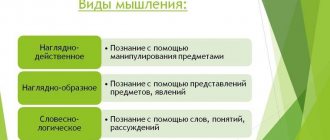Thinking and speech are closely related to each other, however, they cannot be called unequivocally one and the same. It also cannot be said that one stems from the other, but one should not deny the connection between thinking and speech. Speech has its own tools for managing it, called grammar, while thinking operates with logic and logical concepts. Logic and grammar are completely different tools that perform completely different functions. They cannot be equated to each other from any point of view. In addition to the above, it is worth noting that although speech and thinking historically helped each other develop, they still occurred separately and initially performed different functions in human life.
Interrelation of concepts
The psychology of thinking and speech examines these concepts in a complex manner. It is thanks to them that humans differ from animals. Animals think simply, elementarily. They are not distracted from the process of thinking by mediated consciousness. Because of this, they only pay attention to visible objects.
A person uses speech to name an object with a special word. The verbal shell allows you to make a thought material in order to continue its study without visible objects.
Thinking without knowledge of speech is impossible. Moreover, the deeper you think through a thought, the more words you will need to describe it verbally or in writing.
Problems of the relationship between thinking and speech in Vygotsky
Figure 1. Lev Semyonovich Vygotsky. Author24 - online exchange of student work
Soviet scientist Lev Semyonovich Vygotsky, born in 1896, did a lot of studying the relationship between speech and thinking, including researching psychological functions, based on data obtained from child psychology, defectology and psychiatry. His work entitled “Thinking and Speech,” published in 1934, examines aspects of the development of speech and thinking, and also examines the inconsistency of the relationship of these two concepts to each other and the difference in their origin. In his work, Vygotsky suggests that there was a certain pre-verbal phase of intelligence and a special pre-intellectual phase of speech. In his opinion, at a certain historical moment there is a collision of speech and thinking, as a result of which they continue to develop hand in hand in the future.
Vygotsky also had a special view on the formation of internal speech: he assumed that it develops first through the accumulation of internal and functional changes, and then egocentric speech “aloud” appears. Over time, the child begins to separate the egocentric and social functions of speech, after which egocentric speech gradually turns into internal speech.
Note 1
The book “Thinking and Speech” is the beginning for such a Soviet science as psycholinguistics.
Also in his work, Vygotsky showed how important speech is for personality development. The fact is that speech, which arose separately from the process of thinking and then gradually became its important component, is used to transform the visual-figurative flow of thought into a logical and, accordingly, into an abstract one, and this makes it possible to operate with those concepts that we do not understand. able to somehow explore with the help of all the senses.
Moreover, if we consider the word separately from the thinking process, then it loses its essence and becomes an empty set of sounds. But if a word acquires meaning, it can immediately become a tool for both speech and thinking. This is precisely what Vygotsky considered to be the unifying factor for the concepts of “word” and “thinking.”
Historical sketch
Researchers involved in the study and development of psychological science do not deny direct connections between speech and thinking, but their opinions regarding their genetic origin differ.
The first scientist who made a major contribution to the study of the relationship between these two concepts was L.S. Vygotsky. He proved that speech and thinking should be studied from the perspective of different roots.
At the same time, linguists contradicted him. They argued that human behavior cannot be linked to its speech.
Another theory that proves the relationship between thinking and speech is the Sapir-Whorf doctrine. Using this concept, researchers have proven that thanks to the structure of language, thinking and different ways of understanding reality are formed.
What is the manifestation of activity?
It is common for a person to carry out transformative activities. At the same time, a person behaves by adapting. In particular, at the beginning of their development, people tended to adapt to geographical and climatic conditions. Indeed, when the river bed changed and the fields were flooded, significant changes occurred in the lives of the people living nearby. First of all, this affected economic activity.
Gradually, man built dams, canals, and irrigation systems. Man has subjugated the natural elements. That is, people transform nature, and not just adapt to it. This is the significant difference between humans and representatives of the animal world.
Classification
Types of speech:
- Monologue, dialogic. Monologue is considered more complex, since a person tells something to others, while no one helps him or suggests. Dialogical - communication between different people. It is considered simpler.
- Descriptive is the most complex type of speech, which is associated with presentation and description.
- Internal, external. Internal speech cannot exist without external speech. Its main functions are regulation and planning. External - oral, loud.
- Written, oral. Written language is considered later and more complex. It can only be learned from other people. Oral is simpler. People learn it on their own.
Types of thinking:
- Visual-figurative. They are used to solve mental problems with the help of visual images and situations from personal experience.
- Visually effective. With its help, an individual solves mental problems by interacting with a specific object.
- Verbal and logical. Mental problems are solved using judgments, concepts, and inferences.
According to the nature of the problems being solved, thinking is divided into two groups:
- Practical - with its help, a person outlines a goal, draws up a plan that is designed to solve a practical problem.
- Theoretical - with its help people solve cognitive problems.
Power is in words
Sometimes a person doesn’t even realize what an extraordinary ability he has. He can talk! Only man can do this, and no other living creature in the world. It is very important to be able to control your speech. Preferably, all its types, of which there are many. Unfortunately, the majority uses only oral communication – through verbal communication.
But there is also a written one. Text speech involves the use of graphics and syntactic structures, compliance with the composite structural organization. To create good, readable text, a person must be a thinker. Because it’s not enough to just write. This must be done in such a way that the reader understands what the author was trying to convey to him. That is why all speakers compose the texts of their speeches. People preparing a speech first write it on paper and then rehearse it.
Characteristics
Thought processes:
- proceed based on an already existing knowledge base;
- associated with the activities of the individual;
- reflect the relationship in verbal form;
- come from living contemplation.
Characteristics of thinking:
- productivity;
- speed, pace;
- focus;
- harmony, which can be logical, grammatical.
Characteristics of speech:
- Voice is a practical means of communicating emerging thoughts to other people. When used correctly, voice skills can be used as a powerful tool to influence others.
- Pace. This concept describes speech speed, the pronunciation of individual words with certain delays. If an individual has professional speech skills, he can easily adjust the pace, depending on what information he is presenting.
- Volume. Depending on the circumstances, the individual changes the volume of his voice. Some words need to be emphasized loudly in order to draw the attention of others to them.
- Voice pitch. With its help, you can convey your psychological state to others. For example, if a person uses a deep voice, they seem much more confident.
- Intonation. With its help, you can interpret the same words differently. Only with the help of intonation can you make an interrogative or exclamatory sentence if there is an oral description.
To build a constructive dialogue with others, you need to be able to influence other people.
From thoughts to actions
Surely this phrase is well known to everyone. And it contains the answer to the question mentioned above.
An activity is a human activity that carries a certain meaning. In any case, no matter what it concerns, it is divided into stages. The first step is to set a goal. Motivation is important here. Goal setting and the search for motivation are associated with a process of analysis, during which a person “disassembles” the situation into bricks, after which he designs his actions. Then comes the process of implementing them (how long it lasts depends on the goal) and achieving the result.
A simple example: a person wants to buy an apartment. Let's say for 1,500,000 rubles. The goal is to earn this amount. The motivation lies in the desire to gain property, a personal “roof over one’s head” and a certain independence. Action planning: find a job with a minimum income of 45,000 rubles. Of which 30,000 will be set aside for the purchase of property - then in 50 months (if you follow the plan) the goal will be achieved. When the amount is accumulated and housing is purchased, a person will compare his results with expectations, check whether he met the deadline, etc. This example shows that every action (that is, activity) is associated with thinking - with analysis, reasoning, making calculations, drawing up a plan and drawing some conclusions for yourself.
Functions and properties
Modern psychologists distinguish two functions of speech:
- as one of the tools of thinking;
- as a means of communication.
The first function is divided into two subgroups:
- generalization - individual words are related to each other in meaning;
- signaling - with words an individual designates an event or phenomenon.
The second function is divided into 7 subgroups:
- Expressive speech. With its help, a person conveys emotions regarding the words of another person, his own beliefs.
- Communicative - with its help people exchange information.
- Cognitive - it is associated with the study of subjects.
- Expressive - facial expression, facial expressions.
- Primary functions of influence.
- Significative - the individual examines an object and denotes its properties in words.
- Signal is a special function for understanding.
The connection between language and consciousness
Language is a means of communication between people and is an important component of society. It arose as a result of the joint work of people and the need to create a set of sounds denoting a particular action. Gradually, this system of sounds turned into a stable, perfect language.
A feature of language is the transmission with its help of the results of knowledge of reality, knowledge and thoughts of other people.
Along with language, the reflection of reality—consciousness—developed.
It is worth distinguishing between public and individual consciousness. The social represents the mental reflection of reality by society. Individual - the concepts and ideas of a specific person.
Assimilated ideas are comprehended in a person’s head. They can evoke certain feelings, or leave him indifferent. These psychological characteristics are determined by the circumstances of life and individual qualities. Psychology studies this.
Violations
Speech disorders are called aphasia. There are 7 types of disease:
- Efferent motor. The patient loses the ability to combine sounds with each other, which is why he continues to pronounce individual simple syllables.
- Optical-monistic. People suffering from this form of the disease cannot describe actions, images, or objects.
- Semantic. The patient cannot build logical connections between individual words in sentences.
- Dynamic. People with this disease stop speaking phrases and replace them with simple phrases.
- Sensory. The patient hears other people, but does not understand what they are saying.
- Afferent motor. The individual confuses individual sounds in the process of speaking.
- Acoustic-monistic. There are difficulties in writing words and sentences under dictation.
Disorders of thought processes:
- fragmentation, incoherence;
- slow or accelerated formation of thoughts;
- the appearance of obsessive thoughts;
- delirium;
- reassessment of real facts;
- fruitless thoughts, reasoning.
Thinking disorders are caused by somatic and psychological diseases.
Learn more about logical operations
Each of the above-mentioned logical operations helps to understand how thinking, speech and human activity are connected. In particular, analysis is carried out with the aim of gaining a deeper understanding of something. It consists of decomposing an object into its component parts. Thanks to analysis, it is possible to understand the structure of the subject under consideration. At the same time, its properties appear more specific, and cognition becomes accessible to humans and completely real.
But simply decomposing an object into its components is simply not enough to understand its essence. Therefore, the next step is to establish connections between the discovered parts. This is what synthesis does. That is, after objects have been isolated through analysis, they are connected.
Comparison is the identification of common characteristics and insignia. Thus, over the years, man has been able to discover new laws. That is, stable connections between objects and events were identified. Thanks to established laws, man was able to influence social life and nature.
The main forms of thinking are also represented by judgments and inferences. Judgment consists of agreement or denial of some phenomenon. Inferences emerge based on judgments. They represent a mental process aimed at deriving a new proposition from existing ones.
Research methods
There are several methods that are used to study speech and thinking:
- observation;
- conversations;
- experiments;
- survey;
- testing;
- software, mathematical modeling of thought processes.
There are several sciences that deal with in-depth study of speech:
- graphology;
- rhetoric;
- psycholinguistics;
- linguistics.
Each of them studies individual manifestations of speech, handwriting, written and oral expression.
Development methods
Thinking and language skills can be developed at any age.
For this, psychologists are creating new methods and exercises, many of which are effective for both adults and children.
Methods for developing speech skills:
- Visual - they allow you to create a rich theoretical basis for the further development of speech. To do this, the individual must travel, visit exhibitions, museums, and theaters.
- Verbal - reading works, memorizing passages of texts, generalizing conversations, retellings.
- Practical - didactic exercises, round dance games, plastic sketches.
People who have poorly developed thinking cannot actively develop creatively, have difficulty describing objects, phenomena, and building logical connections between them.
Groups of exercises for developing thinking:
- Comparative methods. Their goal is for the person to name as many differences as possible between two or more objects.
- Recreation of existing or fantastic images. Using this technique, you can develop your imagination, learn to describe objects, phenomena, and their changes under the influence of external factors.
To develop thinking and speech in children, you need to transform practices into exciting games.
They will help your child not get tired during the learning process, absorb new information with ecstasy, and develop skills.
Thinking and speech are inseparable. Only with the help of speech skills can an individual determine individual properties of objects for their further in-depth study. Impaired thought processes will affect human speech and vice versa. Exercises are used to develop thinking and speech skills.
The nature of speech
Speech is a structure used by man since time immemorial. In this regard, there is no clear answer to the question of whether the human ability to speak is innate, or whether speech is an acquired skill for everyone. There are different approaches to this issue, taking one side or the other.
For example, people who grew up without interaction with society cannot master any human language, which would seem to indicate that speech is an acquired skill.
At the same time, there are facts that suggest that speech is an innate ability. The baby is able to recognize the sound of human speech among many other similar sounds. Another interesting phenomenon is that in all children the development of speech skills occurs according to the same pattern, which partly also speaks of certain innate abilities for speech.
There are many hypotheses suggesting the origin of speech. Below are some of them:
- Learning Theory;
- Chomsky's theory of specific inclinations;
- Piaget's cognitive theory;
- Psycholinguistic theory of speech development.
Learning theory
Learning theory suggests that from birth a child is inclined to imitate. He first imitates sounds, then words, and then clumsily constructs his first sentences. His first words usually play the role of sentences that briefly describe his desires and motives, an excellent example here would be the word “am” used by kids, which can simultaneously mean both his desire to snack and what he is eating at the moment.
The child receives positive reinforcement from the parents after pronouncing the first sounds and then words, partly this helps him learn new words and grammatical structures and remember them. But what is surprising is that at the stage of sentence formation, parents usually encourage more competent logical conclusions and inventions, and not the correctness of grammatical structures as such. Contrary to this, the child also learns grammatical rules. Also, this theory does not take into account the child’s ability to form words and the child’s very rapid acquisition of speech at a certain period of his life, as well as the need to have inclinations for the development of any skill.
Chomsky's theory of specific inclinations
This theory assumes that a newborn person already has certain abilities to develop speech as such, which are normally formed by the age of one year. From this moment on, the child is very sensitive to the perception of speech, and this period continues until about three years of age, which generally theoretically explains why people removed from human society for a long time in childhood are not able to master any language. At the same time, this is the period of development and formation of speech, while the process of thinking continues to develop in a person until he matures.
Piaget's cognitive theory
According to this theory, a child from birth is inherent in the function of perception and some processing of information. That is, a child is born with a mentality that develops over time. This theory helps explain why a child can make up his own words. Another interesting fact that indirectly confirms this theory is that children at the beginning of speech development speak only about what they already understand.
Psycholinguistic theory of speech development
This theory suggests that speech arises through an endless cycle of thinking and speaking, during which gradual improvement of both occurs. Speech for thinking acts as a kind of symbols that allow you to “dress” thought for its formation, at the same time, with the improvement of thinking ability, it is necessary to expand vocabulary and speech, which also leads to its development.









